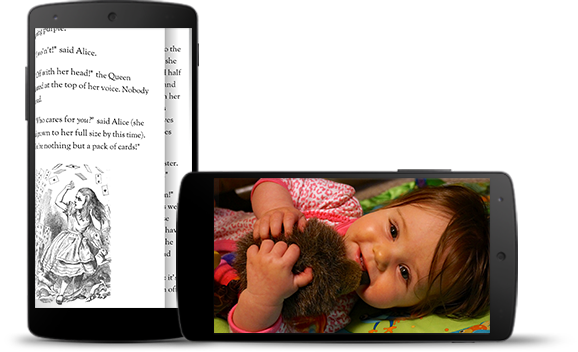部分內容適合以全螢幕模式觀看,且狀態列或導覽列上不顯示任何指標。例如影片、遊戲、圖片庫、書籍和簡報投影片。這稱為「沉浸模式」。本頁說明如何透過全螢幕內容,進一步吸引使用者。

沉浸模式可避免使用者在遊戲中意外退出,並提供沉浸式體驗,讓使用者盡情欣賞圖片、影片和書籍。不過,請留意使用者進出應用程式的頻率,他們可能只是想查看通知、臨時搜尋或執行其他動作。由於沉浸模式會導致使用者無法輕鬆存取系統導覽功能,因此只有在沉浸模式能帶來的好處不只是使用額外螢幕空間時,才建議使用。
使用 WindowInsetsControllerCompat.hide() 隱藏系統資訊列,並使用 WindowInsetsControllerCompat.show() 顯示系統資訊列。
以下程式碼片段範例說明如何設定按鈕,以隱藏及顯示系統資訊列。
Kotlin
override fun onCreate(savedInstanceState: Bundle?) { ... val windowInsetsController = WindowCompat.getInsetsController(window, window.decorView) // Configure the behavior of the hidden system bars. windowInsetsController.systemBarsBehavior = WindowInsetsControllerCompat.BEHAVIOR_SHOW_TRANSIENT_BARS_BY_SWIPE // Add a listener to update the behavior of the toggle fullscreen button when // the system bars are hidden or revealed. ViewCompat.setOnApplyWindowInsetsListener(window.decorView) { view, windowInsets -> // You can hide the caption bar even when the other system bars are visible. // To account for this, explicitly check the visibility of navigationBars() // and statusBars() rather than checking the visibility of systemBars(). if (windowInsets.isVisible(WindowInsetsCompat.Type.navigationBars()) || windowInsets.isVisible(WindowInsetsCompat.Type.statusBars())) { binding.toggleFullscreenButton.setOnClickListener { // Hide both the status bar and the navigation bar. windowInsetsController.hide(WindowInsetsCompat.Type.systemBars()) } } else { binding.toggleFullscreenButton.setOnClickListener { // Show both the status bar and the navigation bar. windowInsetsController.show(WindowInsetsCompat.Type.systemBars()) } } ViewCompat.onApplyWindowInsets(view, windowInsets) } }
Java
@Override protected void onCreate(Bundle savedInstanceState) { ... WindowInsetsControllerCompat windowInsetsController = WindowCompat.getInsetsController(getWindow(), getWindow().getDecorView()); // Configure the behavior of the hidden system bars. windowInsetsController.setSystemBarsBehavior( WindowInsetsControllerCompat.BEHAVIOR_SHOW_TRANSIENT_BARS_BY_SWIPE ); // Add a listener to update the behavior of the toggle fullscreen button when // the system bars are hidden or revealed. ViewCompat.setOnApplyWindowInsetsListener( getWindow().getDecorView(), (view, windowInsets) -> { // You can hide the caption bar even when the other system bars are visible. // To account for this, explicitly check the visibility of navigationBars() // and statusBars() rather than checking the visibility of systemBars(). if (windowInsets.isVisible(WindowInsetsCompat.Type.navigationBars()) || windowInsets.isVisible(WindowInsetsCompat.Type.statusBars())) { binding.toggleFullscreenButton.setOnClickListener(v -> { // Hide both the status bar and the navigation bar. windowInsetsController.hide(WindowInsetsCompat.Type.systemBars()); }); } else { binding.toggleFullscreenButton.setOnClickListener(v -> { // Show both the status bar and the navigation bar. windowInsetsController.show(WindowInsetsCompat.Type.systemBars()); }); } return ViewCompat.onApplyWindowInsets(view, windowInsets); }); }
您可以選擇指定要隱藏的系統資訊列類型,並決定使用者與系統資訊列互動時的行為。
指定要隱藏的系統資訊列
如要指定要隱藏的系統資訊列類型,請將下列其中一個參數傳遞至 WindowInsetsControllerCompat.hide()。
使用
WindowInsetsCompat.Type.systemBars()隱藏兩個系統資訊列。使用
WindowInsetsCompat.Type.statusBars()即可只隱藏狀態列。使用
WindowInsetsCompat.Type.navigationBars()僅隱藏導覽列。
指定隱藏系統資訊列的行為
使用 WindowInsetsControllerCompat.setSystemBarsBehavior() 指定使用者與隱藏的系統資訊列互動時,系統資訊列的行為方式。
使用
WindowInsetsControllerCompat.BEHAVIOR_SHOW_BARS_BY_TOUCH,在相應螢幕上任何使用者互動時顯示隱藏的系統資訊列。使用
WindowInsetsControllerCompat.BEHAVIOR_SHOW_BARS_BY_SWIPE即可在任何系統手勢中顯示隱藏的系統資訊列,例如從隱藏資訊列的螢幕邊緣滑動。使用
WindowInsetsControllerCompat.BEHAVIOR_SHOW_TRANSIENT_BARS_BY_SWIPE透過系統手勢暫時顯示隱藏的系統資訊列,例如從隱藏資訊列的螢幕邊緣滑動。這些暫時性系統資訊列會重疊顯示在應用程式內容上,可能具有一定程度的透明度,並會在短暫逾時後自動隱藏。

